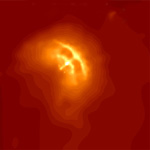June 6, 2000
CXC PR: 00-17
In one of its most bizarre images yet, NASA's Chandra X-ray Observatory shows the details of a compact nebula that resembles a gigantic cosmic crossbow. The nebula, located in the Vela supernova remnant, is created as a rapidly rotating neutron star, or pulsar, spins out rings and jets of high-energy particles while shooting through space.
"What is fascinating is that the jets from the pulsar are directed exactly along the direction of the pulsar's motion," said Dr. George Pavlov of Penn State University, University Park today at the 196th national meeting of the American Astronomical Society in Rochester, New York. "The southern jet looks like a rocket exhaust!"
The X-ray jet can be traced all the way in to the neutron star, and an inner ring is seen for the first time. This ring is thought to represent a shock wave due to matter rushing away from the neutron star. More focused flows at the neutron star's polar regions produce jets of particles that blast away at near the speed of light.
Pavlov explained that shortly after the star exploded, jets with unequal thrust along the poles of the neutron star could have accelerated it like a rocket. The neutron star is enveloped in a cloud of high-energy particles emitting X rays as they spiral around magnetic field lines. This cloud, or nebula, is embedded in a much larger cloud produced by the supernova and has a swept-back, cometary shape because of its motion through the larger cloud.
The dramatic bow-like structure at the leading edge of the nebula is perpendicular to the jets and has the appearance of a cosmic crossbow with the jets as the arrows. This bow and the smaller one inside it, are thought to be the near edges of tilted rings of X-ray emission from high-energy particles produced by the central neutron star.
The neutron star-ring-jet system, which resulted from an explosion in the constellation Vela ten thousand or more years ago, is similar to the remarkable structure observed by Chandra in the Crab Nebula, another powerful pulsar source. The Vela observation of the jet and ring system is especially significant, because it shows that the Crab Nebula system is not unique.
A neutron star is formed by the extreme conditions created in a supernova. When a massive star explodes, most of the star is flung into space, but the core of the star is compressed to form a rapidly rotating‹presently 10 times per second for the Vela neutron star‹dense ball of neutrons that is about twelve miles in diameter. The collapse and rapid rotation of the neutron star cause it to become highly magnetized. A magnetized, rapidly rotating neutron star such as the Vela pulsar can produce electric voltages of ten quadrillion volts. Particles are pulled off the neutron star and accelerated to speeds near the speed of light. A blizzard of electrons and anti-matter electrons, or positrons, is produced by these particles. The jets, rings, and pulsed emission from the Vela pulsar, observed at wavelengths from radio through gamma rays, is thought to be caused by this process.
The Vela pulsar was observed with the Chandra High Resolution Camera (HRC) on 2000 January 20, January 28, and February 21, and with the Advanced CCD Imaging Spectrometer (ACIS) on 2000 April 30. The research team for this investigation also includes Dr. Slava Zavlin and Dr. Vadim Burwitz of the Max Planck Institute in Garching, Germany, Dr. Divas Sanwal and Professor Gordon Garmire of Penn State, Dr. Stephen Murray of the Harvard-Smithsonian Center for Astrophysics, Cambridge, MA, and Dr. Richard Dodson of the University of Tasmania, Hobart.
The HRC was built for NASA by the Smithsonian Astrophysical Observatory. ACIS was developed for NASA by Penn State and MIT. NASA's Marshall Space Flight Center in Huntsville, Alabama, manages the Chandra program. TRW, Inc., Redondo Beach, California, is the prime contractor for the spacecraft. The Smithsonian's Chandra X-ray Center controls science and flight operations from Cambridge, Massachusetts.
Images associated with this release are available on the World Wide Web at:
MEDIA CONTACTS
Barbara Kennedy
Penn State PIO, University Park, PA.
Phone: 814-863-4682
Steve Roy
Marshall Space Flight Center, Huntsville, AL
Phone: 256-544-6535
Dr. Wallace Tucker
Chandra X-ray Observatory Center, CfA, Cambridge, MA
Phone: 617-496-7998



